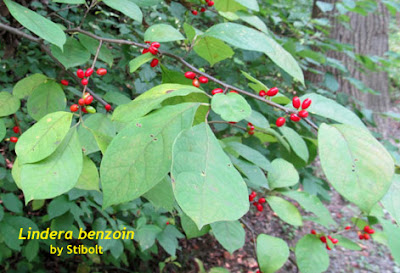 |
| A view of the Naval Academy from across the Severn River with a fringe of cordgrass in the foreground. |
I spent much of my adult life just north of Annapolis, a delightful place for so many reasons. Last week my husband and I made the trip north to familiar territory for a send-off party for grandson Weber Stibolt, who's heading off to the University of Delaware this fall. He'd just come back from an orientation, which included two days on campus and four days hiking the Maryland section of the Appalachian Trail with a group of ten other freshmen.
Maryland native plantsWhile we were in the area, I couldn't help but notice some of my favorite Maryland native plants. Even though some of them are also native to northern Florida, I don't ever see them in the wild.
Spicebush (
Lindera benzoin) is wonderful in late summer with its bright red ovoid berries. They grow in very damp to moderately damp shady to semi shady areas. When you crush the leaves, they emit a spicy aroma.

Near this shrub, a male butterfly sipped salts and nutrients from a crushed rock driveway.
Spicebush has been collected in a few counties in northern Florida including one south of mine (Clay County). They are important larval food for several species of butterfly including the spicebush swallowtail (
Papilio troilus) and the promethea silkmoth
(
Callosamia promethea).
I bought a spicebush a couple of years ago and planted it near our pond, but it was a really wet year and the pond stayed high inundating the bush for several months--it didn't survive. Now I'm incented to try again.

Devil's walking stick
Here's another common Maryland plant that is also native to northern Florida that I'd like to see more of. The devil's walking stick (
Aralia spinosa). When I took the Woody Plants course at the University of Maryland back in the 70s, the professor described it as coarse in texture and to use it only at the back of an otherwise civilized garden space.
A healthy specimen can grow to twelve feet tall and often nearly as wide. The huge, triply-compound leaves attach directly to the central stalk and can be four or five feet long. At the end of the season the leaves fall off leaving only a thorny central stem. Hence the common name devil's walking stick--only the devil could use it. And the species name "
spinosa" also alludes to its prickliness.
 |
A buckeye butterfly is only one of many pollinators swarming
around the flowers. |
So why would I like to see more of this coarse and prickly plant? While in flower it attracts a wide array of pollinators and the purple berries are devoured by the birds. Besides, I just like the stories of the huge leaves and the thorny walking stick.
Unseen influencesSo even though some of the habitats may look similar in many ways between Maryland and north Florida, there is something that makes these plants much rarer here.
Green Gardening Matters,Ginny Stibolt |
| Ginny and Weber Stibolt |
P.S.
We had a wonderful visit with family and loved the send off party for my grandson, Weber Stibolt. He had so many college credits before he started college (32), that he has already been declared a sophomore! Now that's one way to save a lot of money for his parents. Way to go Weber!








